SEO
Scale Your B2B Google Ads Strategy Across Multiple Languages

Humans are incredibly diverse – and it’s marketing’s job to respect, engage, and nurture that.
Expanding a B2B business from English-only strategies to regional, multi-language campaigns can absolutely be the turning point of your success. In fact, it’s hard to believe that not everyone’s taking advantage of it.
Mass-market, English-only campaigns cost a ton of money. And, with today’s expectation for a high level of personalization across the customer experience, they don’t really bring much to the table.
Multi-language ad campaigns are more effective as a whole and can even help save you money over time.
Why?
Because diverse markets help diversify income and lead to long-term business sustainability.
As more people throughout the world recognize your brand, you have the opportunity to build brand authority and reduce customer acquisition costs.
This is especially true if you’re in the B2B world. Larger deal sizes and complex buyer committees mean longer sales cycles and more opportunities to either impress or irritate local audiences.
And one of the best ways to turn this opportunity into reality is through the strategic use of localized Google Ad campaigns.
Because Google Ads drive conversions quickly, you can show proof of concept to new markets, which establishes a great starting point for long-term international expansion and increased ROI.
Let’s now dive into how this all works.
Localization > Translation
Before you load up 100 new Google Ad campaigns for your B2B target market, there’s one crucial concept to integrate into your processes: Focus on localization over translation.
Here’s a basic overview of the difference:
- Translation involves putting the exact keyword into Google Translate or Deepl and getting literal, word-for-word translations back. I don’t know if you’ve ever tried that when traveling around, but it doesn’t get you much further than asking for directions to the nearest restroom. And when applied to PPC, chances are that directly translated keywords either don’t have search volume or mean something entirely different when used in search (bringing about search intent mismatch).
- Localization is the act of identifying keyword intent and finding an equivalent with search volume in the target language of your choice. To do this, you’ll need to deeply understand the local market, its nuances, and the language they use.
Remember, local competitors are already matching local buyer expectations, so if you don’t start off by already doing that better, you won’t have much success. You can’t copy/paste global campaigns and then sit back, wondering why you’re not seeing the conversions roll in.
Mass website translation alone is not international expansion, and it’s often an efficient use of time and resources when there’s no localized strategy to back it up.
Steps For Developing A Multilingual PPC Strategy For B2B
Developing a multi-language Google Ad strategy takes time, but with the right approach, you can see success rather quickly.
Here, I’ll go through eight steps to help you scale your B2B business across multiple languages and regions.
Step 1: Localize Your Operations
Many companies successfully localize their marketing but forget to make changes when it comes to sales and operations (which actually need to be in place before marketing begins in order to guarantee ROI from the marketing efforts).
The reality is that people buy things differently in different countries. For example, in the US, you can purchase almost anything with a credit card, but in Germany, people don’t use them and much prefer payment by invoice.
The buying cycle in Germany is also much longer in B2B because the work culture is highly process-oriented.
If you don’t localize those areas and expect leads to talk to a salesperson in English with a 9-hour time difference, you definitely won’t do well in closing those leads that marketing has worked so hard to get.
To truly be successful when entering new markets, here are the elements you’ll want to localize:
| Brand Strategy | Buyer Personas | Content | Operations |
| Your USPs | Pain points | SEO keywords | Sales and customer service |
| Your competitors | Buying process & customer journey | Important words and phrases | Product |
| Messaging & cultural relevance | Buying obstacles and how to overcome them | Website in the local language | Payment process |
Step 2: Localize Market Research And Competitors
The next essential step when scaling your multi-language B2B Google ads strategy is to spend time actually learning about your target audience in local markets.
Rather than copy/pasting a generic global strategy, you need to see what brands resonate with locals and which local companies are seeing success.
To help you navigate this process, follow these steps:
- Start by exploring the competition within your chosen market and see what they’re doing to market to local audiences. You can gain access to key metrics using tools like Semrush Advertising Research to see if your competitors are running any paid ads and what keywords they’re bidding on.
To give you a visual idea, the screenshot above shows an example of PPC competitor research solely in the Swedish market.
This is useful because you’ll likely see that not all competitors have localized sites, which is an opportunity that major competitors have missed – good news for you and your niche!
- Then use Semrush Advertising Research to dig into the keywords competitors are bidding on and the types of pages they are using to target these keywords. It’s important to note that some companies may offer a similar service or product but may not necessarily be direct competitors, so you’ll need to filter out any who don’t match.
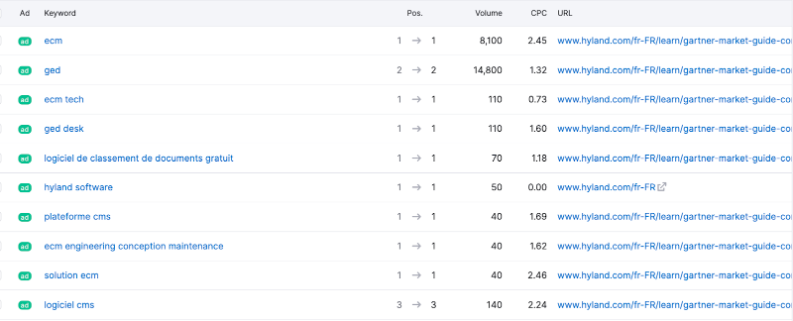 Screenshot from Semrush, July 2023
Screenshot from Semrush, July 2023From this screenshot above for the French market, you can see that one competitor is bidding on a mix of French and English keywords, such as their brand “hyland software.”
- Lastly, take a look at what the competitor’s ad copy looks like. This will give you insight into the types of phrasing used and give you ideas for what you can improve on (as it should always be the goal to surpass competitors, not just match them).
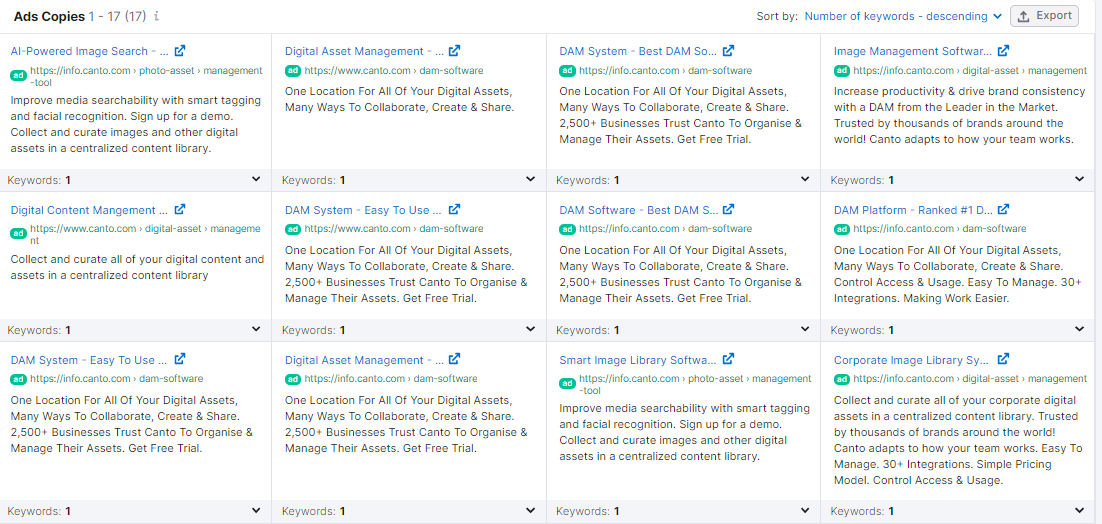 Screenshot from Semrush, July 2023
Screenshot from Semrush, July 2023This particular example shows how the competitor has only used English ads for the Norwegian market.
So there’s again an opportunity for you to offer a better customer experience through localization and target local keywords so that your Google Ads have a better quality score.
Overall, the more thorough you are with localized market and competitor research, the better you’ll be prepared to implement tactics that enable you to outpace them.
Step 3: Localize PPC Keyword Research
All local markets have some element of variation between them, which means that you can’t directly translate keywords. Direct translations don’t capture the differences between search intent among various languages, dialects, and regions.
This is where the concept of localization becomes absolutely crucial.
To effectively localize keywords, follow this process:
- Adapt keywords for localized PPC strategies by identifying keywords that match search intent and have search volume. If you don’t check local search volume and consider similar phrases, it’s easy to lose valuable conversions due to linguistic nuances.
- Interestingly, don’t overlook the power of English keywords as well as localized keywords. Some markets may have English keywords with more search volume than the localized language, and you’ll need to ensure you have ads running for both languages. I’ve found this to be especially true for the B2B tech industry that uses English phrases within the local language.
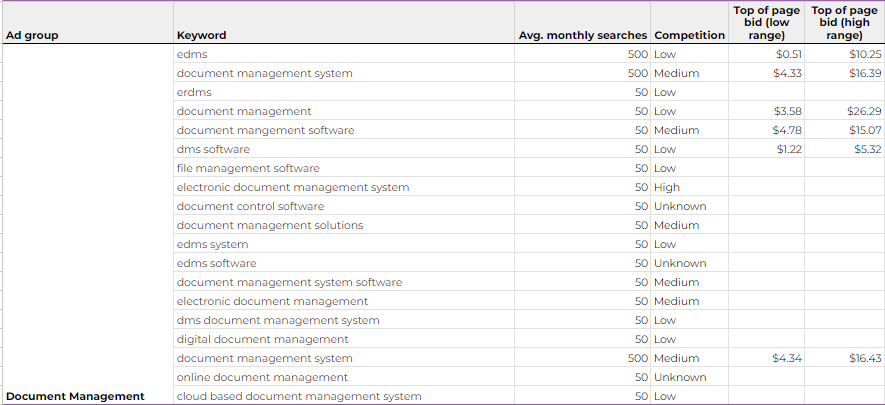
 Screenshots from author, July 2023
Screenshots from author, July 2023For example, in the screenshots above, you can see that document management keywords have been compiled in both Swedish and English. All the keywords came back with different search volumes, but there’s enough to warrant campaigns in both languages.
Note that the keyword “EDMS” is not used in Sweden, so consequently isn’t included in the chosen keywords for Sweden – hence the importance of understanding the market nuances through localization!
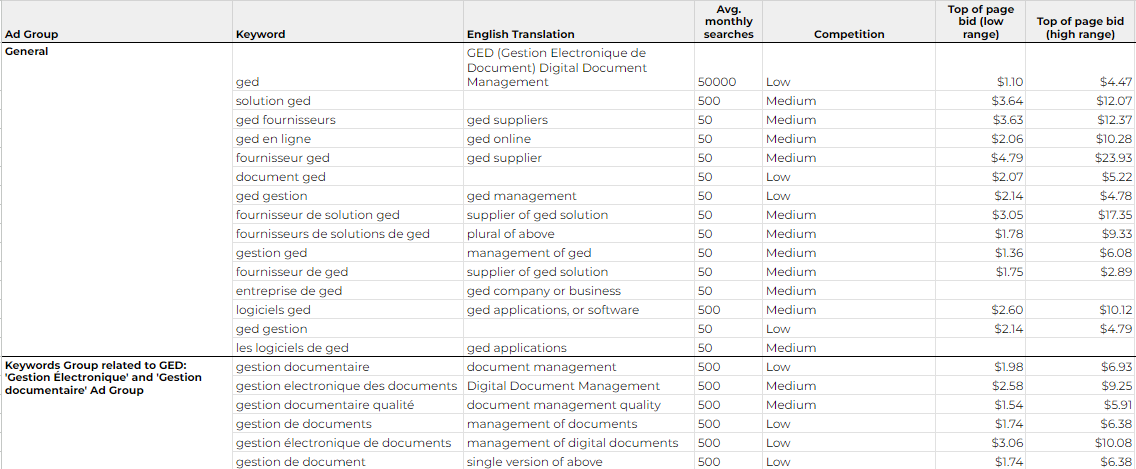 Screenshot from author, July 2023
Screenshot from author, July 2023Another example of the importance of localization is the term “GED,” a common French abbreviation of the word “gestion électronique de documents.”
This is why you can’t just simply translate English keywords, as some of the highest search volume and conversion-focused keywords may end up being excluded from your strategy.
Step 4: Localize PPC Ad Copy
Ad copy localization is where it pays to collaborate with someone who speaks the native language. You’ll need to localize ad copy for the following:
- Brand messaging guidelines.
- Google Ad character limits.
- Local unique selling points (USPs).
- Local pain points.
- Local cultural nuances, both within the language and keywords targeted.
If you were to write ad copy for some of the French keywords compiled in the previous section, it might look like this:
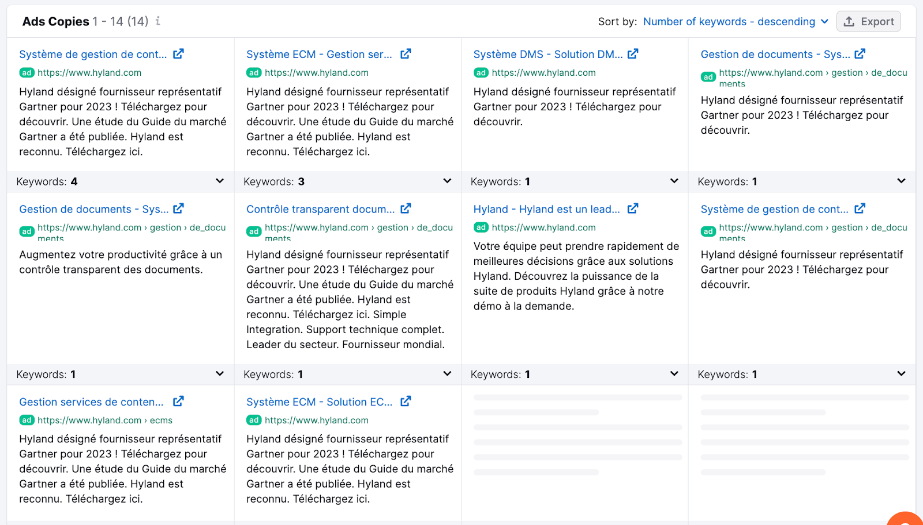 Screenshot from Semrush, July 2023
Screenshot from Semrush, July 2023Step 5: Localize PPC Landing Pages
The copy across the pages needs to contain local keywords in order to maintain a high-quality score (the higher the quality score, the lower the bid costs are).
You’ll also need to focus on addressing the different issues or pain points audiences have across different regions.
To stand out from your competition, prioritize your USP within that particular market. Creative angles can help engage new markets, especially when in comparison with local competitors.
Furthermore, make sure to add some social proof to your landing page. This can be anything from case studies, testimonials, or use cases that match the target audience market. Social proof, in particular, helps your message resonate more strongly.
Step 6: Organize PPC Ad Groups Based On Purchase Intent Stage
Once you have your landing pages localized, you’ll want to organize ad groups based on which part of the sales funnel they’re in, i.e. their level of purchase intent.
A successful Google Ad strategy creates content for and targets keywords based on both transactional and informational search intent.
To organize your campaigns accordingly, use the following steps:
- Define your keywords based on transactional search intent. These will be keywords that precisely describe your products and services and are most oriented toward direct lead generation (or contact with sales).
 Screenshot from author, July 2023
Screenshot from author, July 2023For example, the keywords above describe the main services that a compliance management company wants to run ads for. They’re very conversion-focused and capture the user when they’re looking to make a purchase.
- Then, define your keywords based on informational search intent. These will be keywords that describe topics that your audience needs information on and are relevant for selling your products and services, but your audience isn’t quite ready to buy yet. These types of ads are particularly useful for nurturing users toward conversion in combination with retargeting campaigns.
Splitting out campaigns like this allows you to manage budgets better, as informational keywords tend to be higher in value due to search volume and broadness. However, you still want to own this space to help nurture users toward conversion, so we do need ads here.
And with the correct bid strategy, you can ensure you get the most clicks within your budget. Targeting keywords with both types of intents is more successful than just going for direct conversions, as that can limit your return on investment (ROI) potential over time.
Step 7: Retarget Users To Choose Your Brand Once They’re Ready To Purchase
Once you’re organized, make a strategy for retargeting campaigns. To give you a visual, retargeting display ads often have a structure that looks like this:
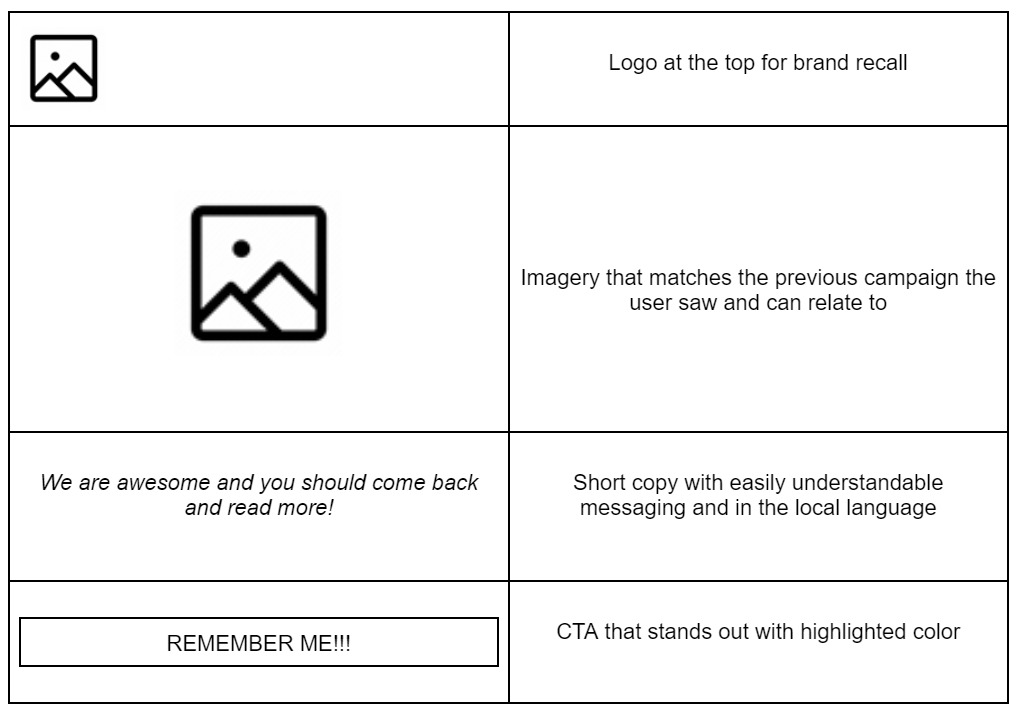 Image created by author, July 2023
Image created by author, July 2023Even though there typically is a CTA, remember that retargeting display campaigns aren’t for directly generating clicks.
When combined with the full funnel campaign approach, they’re meant to keep your brand and products/services top of mind.
Essentially, display ad retargeting is basically like going, “Hey, I’m here whenever you need something. Don’t forget me!”
So you’ll often see an increase in direct website traffic and branded keyword search volume from display ads, as opposed to direct click conversions.
Step 8: Track Multilingual PPC Performance Per Individual Markets
Finally, make sure that you set up conversion tracking for each market, not just globally.
This enables you to determine which markets perform best and where you might need to improve. Some ways to do this include ad campaign performance KPI tracking and conversions per region, such as shown in the below example images:
 Screenshots from author, July
Screenshots from author, July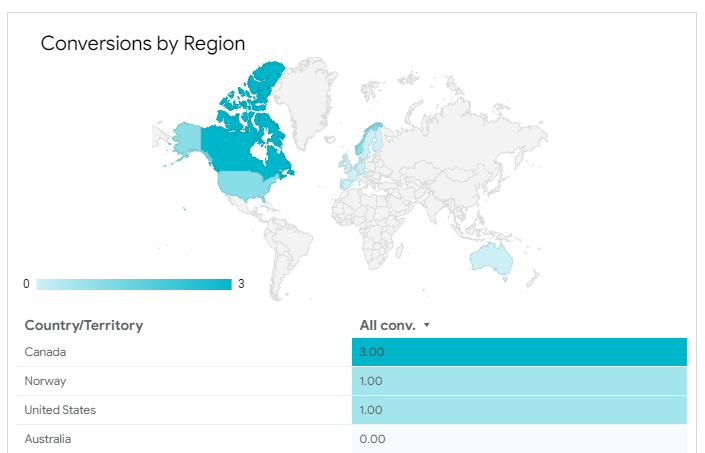
Use Localization Within Your Multilingual PPC Strategy To Convert
If you want to expand your B2B business into international markets with Google Ads – and truly see your efforts pay off – you need to stop the Google Translation use and focus on holistically localizing your strategy.
In doing so, you have the opportunity to make a real, valuable impression on your target audience by matching local customer expectations while also gaining their trust and building your customer base.
While this process does require more effort, it’s a whole lot more effective for generating leads and ensuring that they actually close.
More resources:
Featured Image: Billion Photos/Shutterstock
SEO
Google March 2024 Core Update Officially Completed A Week Ago

Google has officially completed its March 2024 Core Update, ending over a month of ranking volatility across the web.
However, Google didn’t confirm the rollout’s conclusion on its data anomaly page until April 26—a whole week after the update was completed on April 19.
Many in the SEO community had been speculating for days about whether the turbulent update had wrapped up.
The delayed transparency exemplifies Google’s communication issues with publishers and the need for clarity during core updates
Google March 2024 Core Update Timeline & Status
First announced on March 5, the core algorithm update is complete as of April 19. It took 45 days to complete.
Unlike more routine core refreshes, Google warned this one was more complex.
Google’s documentation reads:
“As this is a complex update, the rollout may take up to a month. It’s likely there will be more fluctuations in rankings than with a regular core update, as different systems get fully updated and reinforce each other.”
The aftershocks were tangible, with some websites reporting losses of over 60% of their organic search traffic, according to data from industry observers.
The ripple effects also led to the deindexing of hundreds of sites that were allegedly violating Google’s guidelines.
Addressing Manipulation Attempts
In its official guidance, Google highlighted the criteria it looks for when targeting link spam and manipulation attempts:
- Creating “low-value content” purely to garner manipulative links and inflate rankings.
- Links intended to boost sites’ rankings artificially, including manipulative outgoing links.
- The “repurposing” of expired domains with radically different content to game search visibility.
The updated guidelines warn:
“Any links that are intended to manipulate rankings in Google Search results may be considered link spam. This includes any behavior that manipulates links to your site or outgoing links from your site.”
John Mueller, a Search Advocate at Google, responded to the turbulence by advising publishers not to make rash changes while the core update was ongoing.
However, he suggested sites could proactively fix issues like unnatural paid links.
“If you have noticed things that are worth improving on your site, I’d go ahead and get things done. The idea is not to make changes just for search engines, right? Your users will be happy if you can make things better even if search engines haven’t updated their view of your site yet.”
Emphasizing Quality Over Links
The core update made notable changes to how Google ranks websites.
Most significantly, Google reduced the importance of links in determining a website’s ranking.
In contrast to the description of links as “an important factor in determining relevancy,” Google’s updated spam policies stripped away the “important” designation, simply calling links “a factor.”
This change aligns with Google’s Gary Illyes’ statements that links aren’t among the top three most influential ranking signals.
Instead, Google is giving more weight to quality, credibility, and substantive content.
Consequently, long-running campaigns favoring low-quality link acquisition and keyword optimizations have been demoted.
With the update complete, SEOs and publishers are left to audit their strategies and websites to ensure alignment with Google’s new perspective on ranking.
Core Update Feedback
Google has opened a ranking feedback form related to this core update.
You can use this form until May 31 to provide feedback to Google’s Search team about any issues noticed after the core update.
While the feedback provided won’t be used to make changes for specific queries or websites, Google says it may help inform general improvements to its search ranking systems for future updates.
Google also updated its help documentation on “Debugging drops in Google Search traffic” to help people understand ranking changes after a core update.
Featured Image: Rohit-Tripathi/Shutterstock
FAQ
After the update, what steps should websites take to align with Google’s new ranking criteria?
After Google’s March 2024 Core Update, websites should:
- Improve the quality, trustworthiness, and depth of their website content.
- Stop heavily focusing on getting as many links as possible and prioritize relevant, high-quality links instead.
- Fix any shady or spam-like SEO tactics on their sites.
- Carefully review their SEO strategies to ensure they follow Google’s new guidelines.
SEO
Google Declares It The “Gemini Era” As Revenue Grows 15%

Alphabet Inc., Google’s parent company, announced its first quarter 2024 financial results today.
While Google reported double-digit growth in key revenue areas, the focus was on its AI developments, dubbed the “Gemini era” by CEO Sundar Pichai.
The Numbers: 15% Revenue Growth, Operating Margins Expand
Alphabet reported Q1 revenues of $80.5 billion, a 15% increase year-over-year, exceeding Wall Street’s projections.
Net income was $23.7 billion, with diluted earnings per share of $1.89. Operating margins expanded to 32%, up from 25% in the prior year.
Ruth Porat, Alphabet’s President and CFO, stated:
“Our strong financial results reflect revenue strength across the company and ongoing efforts to durably reengineer our cost base.”
Google’s core advertising units, such as Search and YouTube, drove growth. Google advertising revenues hit $61.7 billion for the quarter.
The Cloud division also maintained momentum, with revenues of $9.6 billion, up 28% year-over-year.
Pichai highlighted that YouTube and Cloud are expected to exit 2024 at a combined $100 billion annual revenue run rate.
Generative AI Integration in Search
Google experimented with AI-powered features in Search Labs before recently introducing AI overviews into the main search results page.
Regarding the gradual rollout, Pichai states:
“We are being measured in how we do this, focusing on areas where gen AI can improve the Search experience, while also prioritizing traffic to websites and merchants.”
Pichai reports that Google’s generative AI features have answered over a billion queries already:
“We’ve already served billions of queries with our generative AI features. It’s enabling people to access new information, to ask questions in new ways, and to ask more complex questions.”
Google reports increased Search usage and user satisfaction among those interacting with the new AI overview results.
The company also highlighted its “Circle to Search” feature on Android, which allows users to circle objects on their screen or in videos to get instant AI-powered answers via Google Lens.
Reorganizing For The “Gemini Era”
As part of the AI roadmap, Alphabet is consolidating all teams building AI models under the Google DeepMind umbrella.
Pichai revealed that, through hardware and software improvements, the company has reduced machine costs associated with its generative AI search results by 80% over the past year.
He states:
“Our data centers are some of the most high-performing, secure, reliable and efficient in the world. We’ve developed new AI models and algorithms that are more than one hundred times more efficient than they were 18 months ago.
How Will Google Make Money With AI?
Alphabet sees opportunities to monetize AI through its advertising products, Cloud offerings, and subscription services.
Google is integrating Gemini into ad products like Performance Max. The company’s Cloud division is bringing “the best of Google AI” to enterprise customers worldwide.
Google One, the company’s subscription service, surpassed 100 million paid subscribers in Q1 and introduced a new premium plan featuring advanced generative AI capabilities powered by Gemini models.
Future Outlook
Pichai outlined six key advantages positioning Alphabet to lead the “next wave of AI innovation”:
- Research leadership in AI breakthroughs like the multimodal Gemini model
- Robust AI infrastructure and custom TPU chips
- Integrating generative AI into Search to enhance the user experience
- A global product footprint reaching billions
- Streamlined teams and improved execution velocity
- Multiple revenue streams to monetize AI through advertising and cloud
With upcoming events like Google I/O and Google Marketing Live, the company is expected to share further updates on its AI initiatives and product roadmap.
Featured Image: Sergei Elagin/Shutterstock
SEO
brightonSEO Live Blog

Hello everyone. It’s April again, so I’m back in Brighton for another two days of Being the introvert I am, my idea of fun isn’t hanging around our booth all day explaining we’ve run out of t-shirts (seriously, you need to be fast if you want swag!). So I decided to do something useful and live-blog the event instead.
Follow below for talk takeaways and (very) mildly humorous commentary. sun, sea, and SEO!
-
SEARCHENGINES7 days ago
Daily Search Forum Recap: April 19, 2024
-

 WORDPRESS7 days ago
WORDPRESS7 days ago7 Best WooCommerce Points and Rewards Plugins (Free & Paid)
-

 MARKETING7 days ago
MARKETING7 days agoBattling for Attention in the 2024 Election Year Media Frenzy
-

 WORDPRESS6 days ago
WORDPRESS6 days ago13 Best HubSpot Alternatives for 2024 (Free + Paid)
-

 MARKETING6 days ago
MARKETING6 days agoAdvertising in local markets: A playbook for success
-

 SEO7 days ago
SEO7 days agoGoogle Answers Whether Having Two Sites Affects Rankings
-

 SEARCHENGINES6 days ago
SEARCHENGINES6 days agoGoogle Core Update Flux, AdSense Ad Intent, California Link Tax & More
-

 AFFILIATE MARKETING7 days ago
AFFILIATE MARKETING7 days agoGrab Microsoft Project Professional 2021 for $20 During This Flash Sale




![The Current State of Google’s Search Generative Experience [What It Means for SEO in 2024] person typing on laptop with](https://articles.entireweb.com/wp-content/uploads/2024/04/The-Current-State-of-Googles-Search-Generative-Experience-What-It.webp-400x240.webp)
![The Current State of Google’s Search Generative Experience [What It Means for SEO in 2024] person typing on laptop with](https://articles.entireweb.com/wp-content/uploads/2024/04/The-Current-State-of-Googles-Search-Generative-Experience-What-It.webp-80x80.webp)









